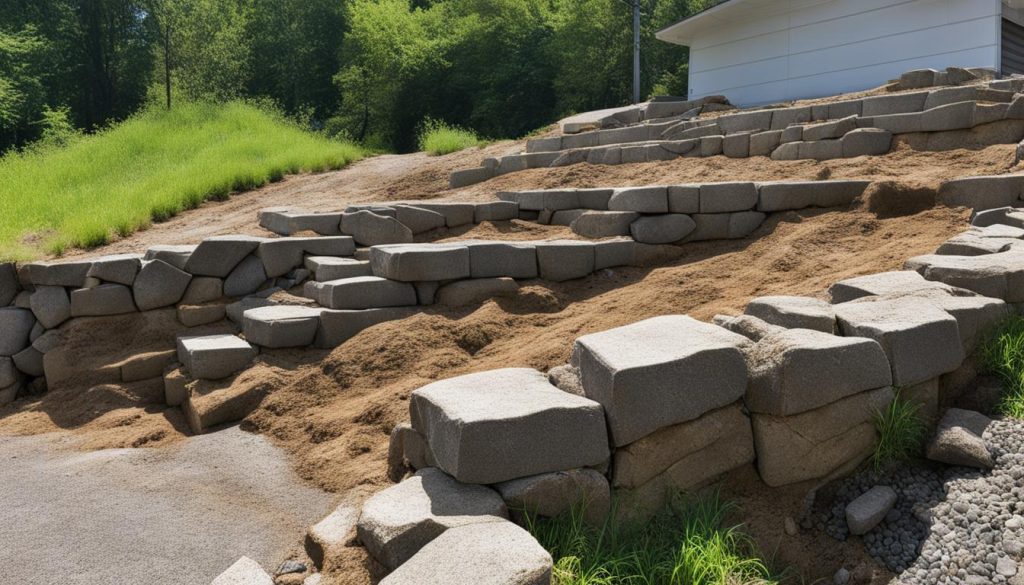As a homeowner, it is essential to understand the signs of retaining wall damage to ensure the safety and stability of your property. Retaining walls are used to prevent soil erosion, manage water flow, and provide support for elevated landscapes. However, over time, these walls can deteriorate due to various factors, such as soil pressure, water accumulation, inadequate drainage, and poor construction.
In this section, we will explore the common signs of retaining wall damage and how to address them. Identifying these issues early on is crucial to prevent further damage and maintain the long-term stability of your retaining wall.
Key Takeaways
- Retaining wall damage can occur due to various factors, such as soil pressure, water accumulation, inadequate drainage, and poor construction.
- Identifying the signs of retaining wall damage early can help prevent further damage and maintain the long-term stability of your retaining wall.
- Signs of retaining wall damage include bulging or leaning walls, cracks in the wall, water accumulation behind the wall, tilting or sunken wall sections, soil erosion at the base of the wall, failing drainage systems, visible tilted or displaced wall caps, vegetation growth on the wall, and crumbling or loose wall materials.
- Regular maintenance and inspection of the retaining wall and drainage system are necessary to prevent potential damage.
- If you suspect retaining wall damage, seek professional help from a qualified retaining wall repair specialist.
Common Signs of Retaining Wall Damage
In this section, we will explore the common signs that indicate your retaining wall may be damaged. Identifying these signs early on is crucial for the long-term stability of your wall.
Bulging or Leaning Wall
One of the telltale signs of retaining wall damage is when the wall appears to be bulging or leaning. This can occur due to soil pressure, erosion, poor construction, or inadequate drainage.
| Signs of a bulging or leaning wall | What it could mean |
|---|---|
| Horizontal cracks near the midsection of the wall | The wall is under too much pressure due to the weight of the soil or water behind it |
| Bowing in the middle of the wall | The soil behind the wall may be saturated with water or there may be poor drainage |
| Wall is leaning away from the soil it’s retaining | The base of the wall isn’t strong enough to support it |
If you notice any bulging or leaning, it is essential to address the issue promptly to prevent further retaining wall damage. Seeking professional help from a qualified retaining wall repair specialist like Retaining Wall Repair can provide expert advice and perform the necessary repairs.
Cracks in the Wall
In this section, we will discuss one of the most common signs of retaining wall damage – cracks in the wall. Cracks can appear due to a variety of factors, including soil movement, hydrostatic pressure, or frost heaving. These cracks can be vertical, horizontal, or diagonal, and their severity can vary depending on the cause of the damage.
It is crucial to address any cracks in your retaining wall promptly to prevent further damage to the wall’s structure. The longer you wait to address the issue, the more extensive the damage can become, and the costlier the repairs will be.
If you notice any cracks, assess their severity and location. Vertical cracks that are less than 1/4 inch wide are generally not a cause for concern. However, if the wall has wider cracks or horizontal or diagonal cracks, it could be a sign of serious damage.
In addition to visible cracks, you may notice other signs of wall damage, such as bulging, soil erosion, or water accumulation. Identifying these signs early on can help you prevent further damage to your retaining wall.
Types of Wall Cracks and Their Causes
| Type of Crack | Cause |
|---|---|
| Vertical Crack | Settlement of soil or hydrostatic pressure from water-saturated soil. |
| Horizontal Crack | Pressure from soil that has expanded due to freezing, or hydrostatic pressure. |
| Diagonal Crack | Uneven settling of soil or hydrostatic pressure. |
As you can see, different types of cracks can indicate different causes of damage. Vertical cracks may result from settling of soil or hydrostatic pressure from water-saturated soil. Horizontal cracks are often due to pressure from soil that has expanded due to freezing or hydrostatic pressure. Diagonal cracks can result from uneven settling of soil or hydrostatic pressure.
It is important to address any cracks in your retaining wall promptly to prevent further damage. A retaining wall repair specialist, like Retaining Wall Repair, can assess the damage and offer expert advice on how to repair the wall. Contact us at (647) 812-9837 or visit our website for more information on retaining wall repairs in Canada.
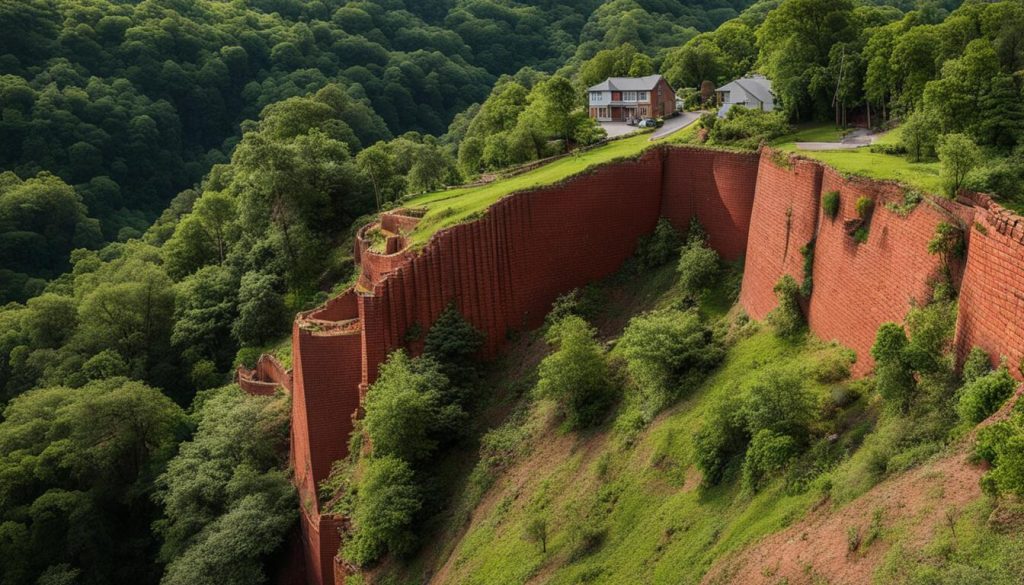
Water Accumulation Behind the Wall
If you observe water pooling or accumulating behind your retaining wall, it could be a sign of retaining wall damage. Excessive water can exert pressure on the wall and weaken its structure. Proper drainage systems should be in place to prevent water accumulation and potential damage.
Let’s take a look at the different types of drainage systems that can help prevent water accumulation:
| Drainage Type | Description |
|---|---|
| French Drain | A trench filled with gravel or rock that redirects water away from the wall. |
| Weep Holes | Small openings in the wall that allow water to drain out. |
| Geotextile Fabric | A permeable fabric that allows water to pass through while filtering out soil particles. |
If your retaining wall already has a drainage system, make sure it is functioning correctly. Inspect it regularly and remove any debris that may block the flow of water. If you suspect a drainage system failure, seek professional help immediately.
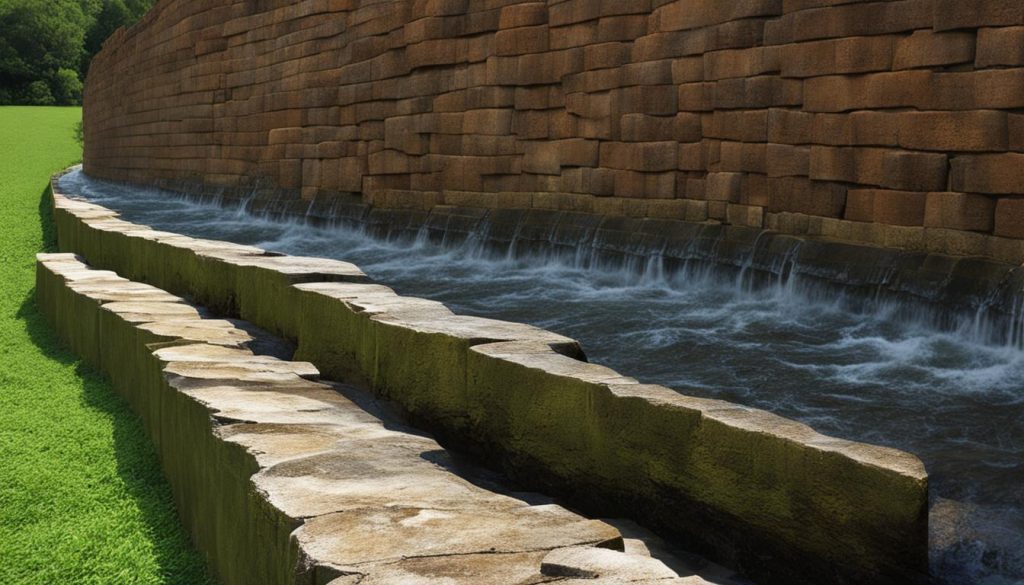
Remember, identifying water accumulation early on is crucial for preventing retaining wall damage. If you notice any signs of water buildup, take action immediately to protect the stability and longevity of your retaining wall.
Tilting or Sunken Wall Sections
If you notice that sections of your retaining wall are tilting or have sunken, it’s time to take action. These signs can indicate structural problems that should be addressed promptly to ensure the stability of the wall.
The most common causes of tilting walls are unequal soil settling or inadequate foundation preparation. The presence of underground utilities can also impact the stability of your retaining wall. Sunken walls, on the other hand, can result from soil erosion or poor water drainage, among other reasons.
To fix the problem, we recommend seeking help from a professional retaining wall repair specialist. They will assess the extent of the damage and offer expert advice on reinforcing the wall. Depending on the degree of damage, different solutions such as adding support to the wall with steel beams or fixing drainage may be required.
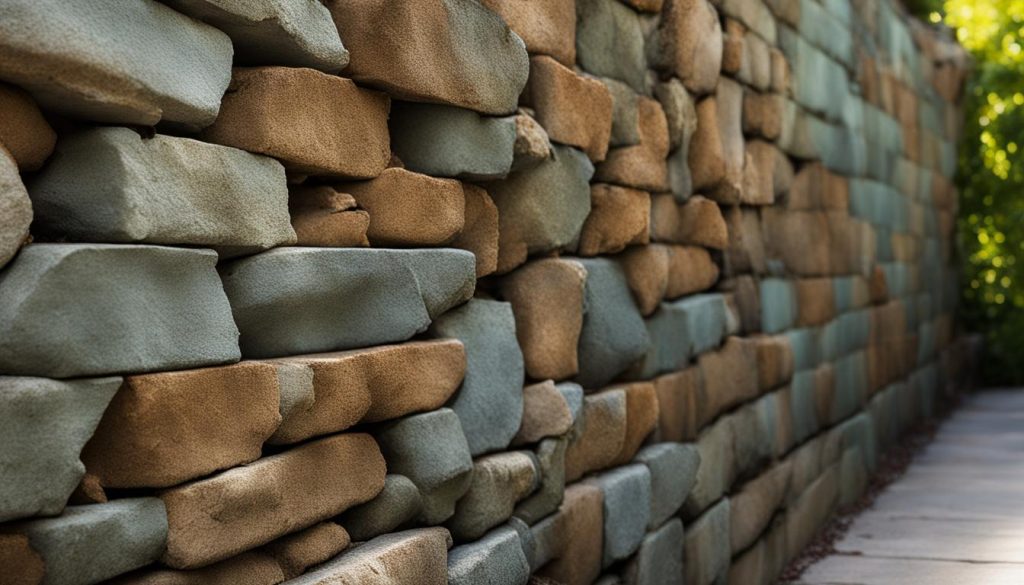
It’s essential to address tilting or sunken walls promptly to avoid further damage. Neglecting to fix the issue can result in more significant, costly repairs later on. A skilled retaining wall specialist can repair the damage and ensure that your wall is stable and secure for many years to come.
Soil Erosion at the Base of the Wall
Soil erosion at the base of your retaining wall can compromise its strength and stability. If left unchecked, it can lead to bulging, cracking, or even collapse of the wall. In some cases, soil erosion at the base of the wall may occur gradually, making it difficult to detect until the damage is significant.
If you notice any signs of soil erosion, such as exposed roots, rocks, or uneven ground, it is crucial to take action immediately to prevent further damage. In some cases, soil erosion may be caused by inadequate retaining wall design, poor drainage, or lack of vegetation cover to stabilize the soil.
One effective way to prevent soil erosion is to install a drainage system at the base of the wall. This system can help manage water runoff and prevent hydrostatic pressure from building up behind the wall. Additionally, planting vegetation like grass or shrubs can help stabilize the soil and prevent erosion.
| Signs of Soil Erosion | Causes |
|---|---|
| Exposed roots, rocks, or uneven ground | Water runoff, poor drainage, inadequate retaining wall design |
| Visible gaps or cracks at the base of the wall | Soil movement, hydrostatic pressure, frost heaving |
| Leaning or bulging sections of the wall | Soil pressure, erosion, poor construction, inadequate drainage |
If you suspect soil erosion or any other damage to your retaining wall, it is essential to seek professional help. At Retaining Wall Repair, we specialize in repairing, reinforcing, and stabilizing retaining walls damaged by soil erosion or other factors. Contact us today for a consultation and get your retaining wall back to its original strength and stability.
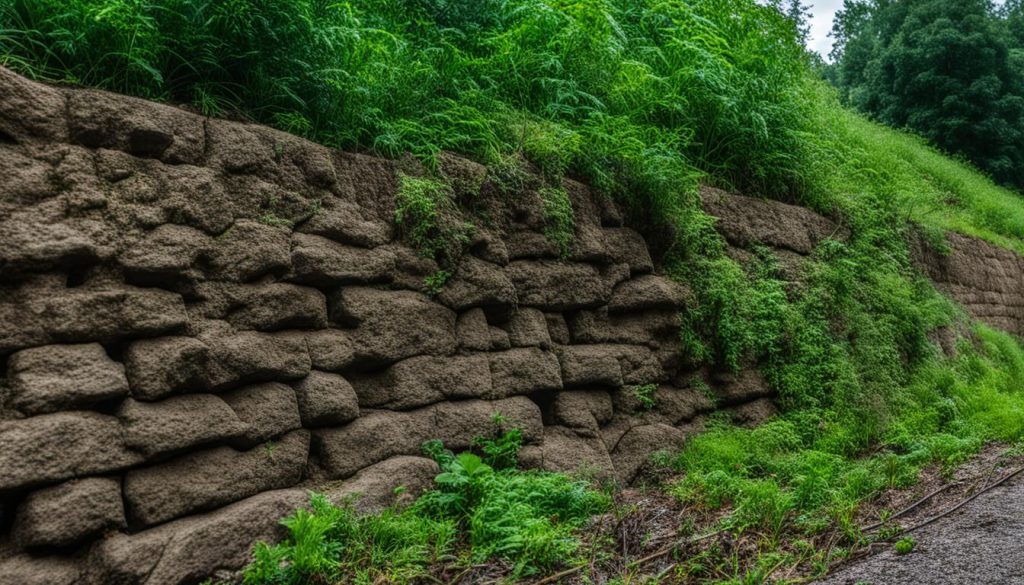
Failing Drainage System
A retaining wall’s drainage system is crucial for preventing water damage to the wall and maintaining its structural integrity. However, a failing drainage system can contribute to retaining wall damage, which can lead to costly repairs or even wall replacement.
There are several signs that your retaining wall’s drainage system may be failing:
- Water accumulation behind the wall
- Soil erosion at the base of the wall
- Vegetation growth on the wall
If you notice any of these signs, it is essential to address your drainage system’s failure immediately.
Causes of Drainage System Failure
There are several causes of a failing drainage system:
| Cause | Explanation |
|---|---|
| Clogged Drainage System | Over time, debris can accumulate in the drainage system, clogging it. This can prevent water from draining away from the wall, leading to water accumulation and potential damage. |
| Insufficient Design | If the drainage system is not appropriately designed for the site, it can lead to water pooling and damage to the wall. A drainage system must account for factors such as soil type, slope, and climate to be effective. |
| Damaged Drainage System | If the drainage system is damaged, it may not work correctly, allowing water to accumulate and damage the wall. Damage can occur from natural causes, such as tree roots, or from human-caused events, such as construction or excavation. |
Regular maintenance and inspection of the drainage system can prevent these issues and ensure the wall’s longevity.
Seeking Professional Help
If you suspect a failing drainage system or retaining wall damage, it is crucial to seek professional help. At Retaining Wall Repair, we have the expertise to assess the damage, provide expert advice, and perform necessary repairs to restore the wall’s strength and longevity.
Contact us at (647) 812-9837 or visit our website for more information and assistance with retaining wall repairs in Canada.
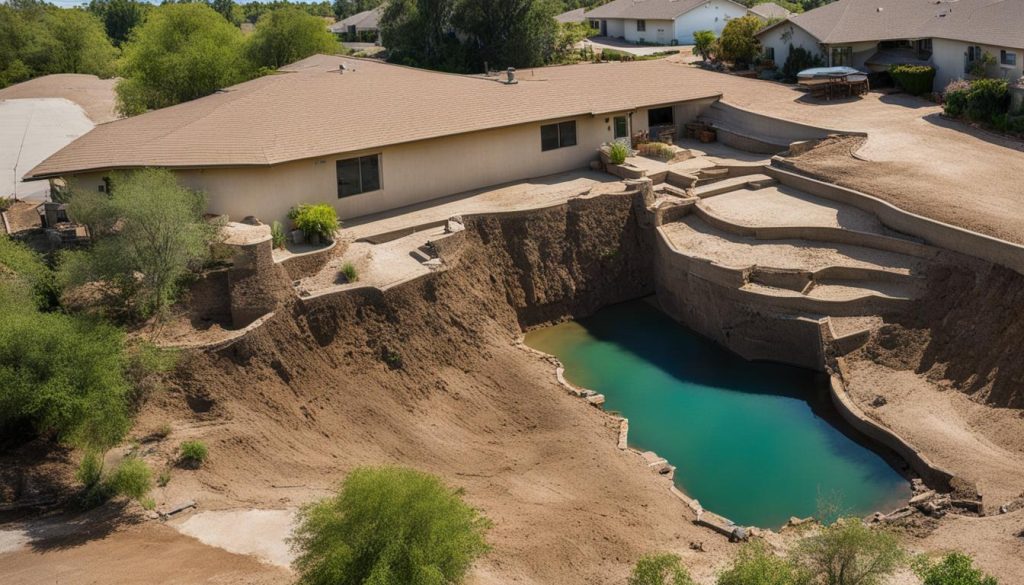
Tilted or Displaced Wall Caps: A Sign of Retaining Wall Damage
If you notice that your retaining wall caps are tilted or displaced, it could indicate damage to the wall’s structure. Wall caps are the horizontal top elements of the wall that provide a finished appearance, and they play a crucial role in protecting the wall from damage by rain, snow, or other environmental factors.
Displaced or tilted wall caps can occur due to various reasons, such as soil movement, inadequate reinforcement, improper installation, or insufficient foundation preparation. These issues can compromise the integrity of the wall and lead to further damage if not addressed promptly.
If you observe any signs of retaining wall damage, including tilted or displaced wall caps, it is essential to seek professional help. A qualified retaining wall repair specialist, like us at Retaining Wall Repair, can assess the damage and provide expert advice and repairs to restore your wall’s strength and stability. Contact us today at (647) 812-9837 or visit our website to learn more about our retaining wall repair services.
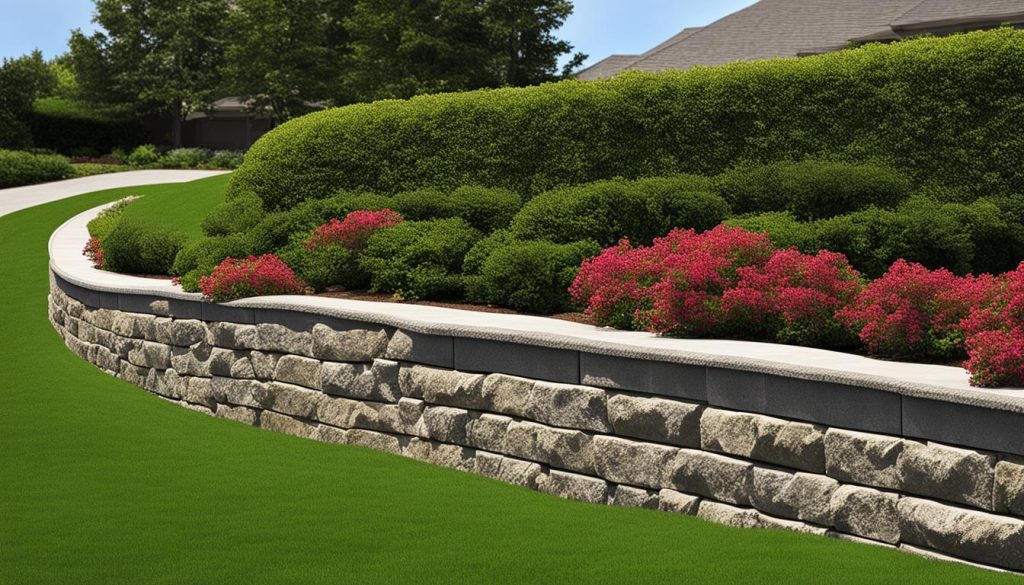
Preventing Tilted or Displaced Wall Caps
Preventing tilted or displaced wall caps begins with proper installation and maintenance of the retaining wall. Here are some steps to help you prevent wall cap issues:
- Ensure proper installation of the wall caps, including proper reinforcement and alignment.
- Regularly check the wall for any signs of damage or instability, including cracks or bulges.
- Manage water runoff effectively by installing a proper drainage system.
- Ensure proper soil preparation and compaction to prevent soil movement.
By following these steps, you can prevent wall cap issues and ensure the long-term stability and durability of your retaining wall.
Vegetation Growth on the Wall
One sign of retaining wall damage that is often overlooked is vegetation growth on the wall. If you notice grass, moss, or weeds growing on your retaining wall, it is a clear sign that moisture is being retained on the wall’s surface. This moisture buildup can place additional stress on the wall and accelerate the rate of deterioration.
While it may seem harmless at first, neglecting vegetation growth on your retaining wall can lead to severe damage in the long run. The roots of plants can penetrate the surface of the wall, causing it to crack and crumble. Moreover, the added weight of the vegetation can cause further damage, especially if the wall is already weakened due to other factors.
To prevent vegetation growth from damaging your retaining wall, regular maintenance and removal of plants are necessary. You can remove the plants manually or use a herbicide solution to prevent regrowth. Additionally, ensure that the wall’s drainage system is functioning correctly to prevent moisture retention.
The following table provides a summary of the risks associated with vegetation growth on retaining walls:
| Risks Associated with Vegetation Growth on Retaining Walls | Solutions |
|---|---|
| Moisture retention on the wall’s surface | Regular maintenance and removal of plants |
| Root penetration and wall damage | Manual removal or use of herbicide solution |
| Added weight contributing to further damage | Regular inspection and maintenance of the wall’s drainage system |
By following these preventative measures, you can prolong the lifespan of your retaining wall and prevent damage caused by vegetation growth. If you suspect your retaining wall has been damaged or need professional help to maintain or repair your wall, contact Retaining Wall Repair or visit our website for more information.
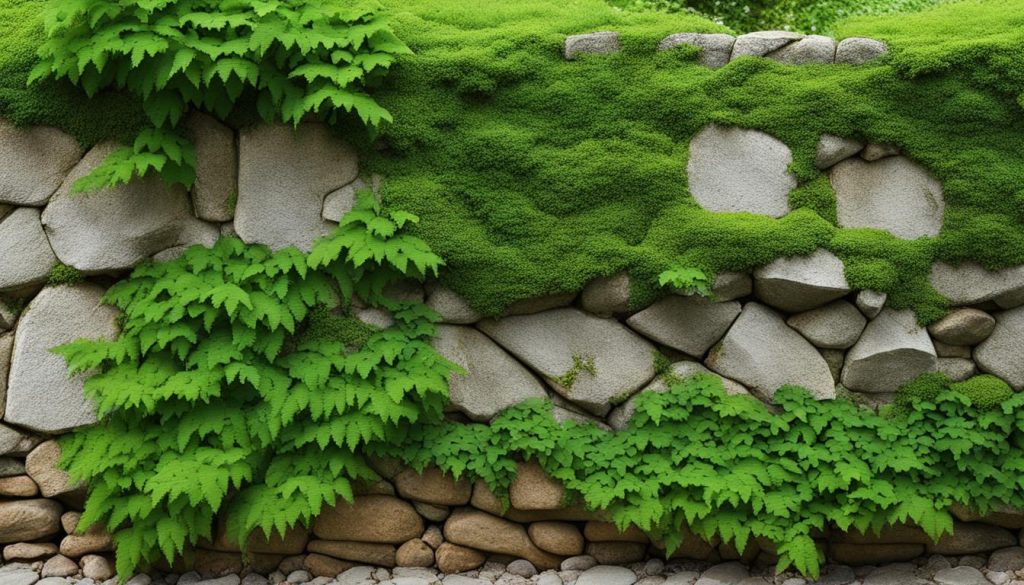
Crumbling or Loose Wall Materials
When your retaining wall starts to appear loose or crumble, it is essential to take action to prevent further damage. Loose wall materials can happen due to several factors like weathering, poor construction, or inadequate reinforcement. It can compromise the structural integrity of the wall, and if left unattended, it can lead to significant damage.
If you notice any signs of retaining wall damage, such as loose materials or crumbling walls, it is essential to seek professional help immediately.
| Retaining wall damage | Crumbling walls | Loose materials |
|---|---|---|
| Vertical, horizontal, or diagonal cracks | Stone or brick work separating | Stones, bricks, or blocks shifting or falling |
| Soil erosion at the base of the wall | Wall bulging or leaning | Excessive vibration |
| Tilting or sunken wall sections | Failing drainage system | Significant weathering |
| Water accumulation behind the wall | Displaced or tilted wall caps | Loose or missing wall materials |
| Vegetation growth on the wall |
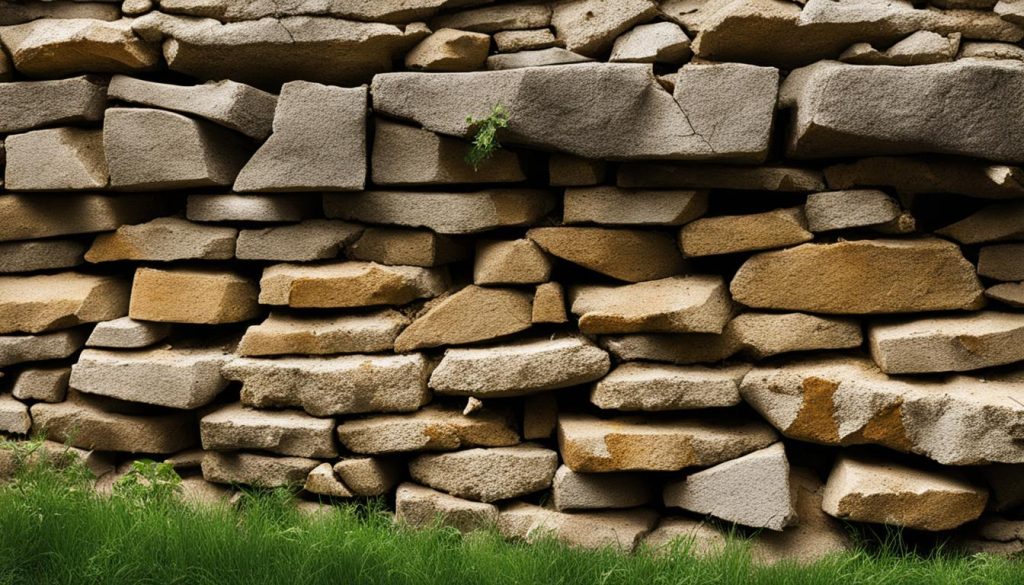
Our team of professionals at Retaining Wall Repair specializes in repairing and restoring retaining walls. We can provide expert advice to assess the damage and recommend the right course of action. Our goal is to restore the integrity and stability of your wall, ensuring it provides long-lasting protection for your property. Contact us at (647) 812-9837 or visit our website for more information on retaining wall repair in Canada.
Taking Action and Seeking Professional Help
If you notice any signs of retaining wall damage, it is essential to take action promptly. Ignoring the problem can result in further deterioration and costly repairs in the future.
At Retaining Wall Repair, we understand the importance of timely retaining wall repairs. Our team of experts has years of experience and expertise in identifying and addressing all types of retaining wall damage.
The Benefits of Professional Help
Professional help can provide several benefits when it comes to retaining wall repair and maintenance:
- We use state-of-the-art equipment and techniques to assess the damage accurately and recommend the best possible repair options.
- We take into account all factors such as soil type, drainage, and environmental conditions to ensure long-term stability and durability of the wall.
- We provide a cost-effective solution that saves you money in the long run as compared to DIY repairs or ignoring the problem altogether.
- We ensure the safety of our clients and their property by adhering to safety protocols and local construction regulations.
By seeking our professional help, you can have peace of mind knowing that your retaining wall is in good hands.
Contact Us Today
If you suspect retaining wall damage or notice any signs of damage such as cracks, bulging, or tilting, reach out to us at (647) 812-9837 or visit our website for a free consultation. We will assess the damage, provide you with expert advice, and recommend a customized solution that meets your needs and budget.
Don’t wait until the problem gets worse. Contact us today to ensure the stability and longevity of your retaining wall.
FAQ
What are the common signs of retaining wall damage?
The common signs of retaining wall damage include bulging or leaning walls, cracks in the wall, water accumulation behind the wall, tilting or sunken wall sections, soil erosion at the base of the wall, failing drainage systems, visible tilted or displaced wall caps, vegetation growth on the wall, crumbling or loose wall materials.
What can cause a bulging or leaning retaining wall?
A retaining wall can bulge or lean due to factors such as soil pressure, erosion, poor construction, or inadequate drainage.
How serious are cracks in a retaining wall?
Cracks in a retaining wall can indicate underlying damage and should be assessed for severity. They can result from factors like soil movement, hydrostatic pressure, or frost heaving.
Why is water accumulation behind a retaining wall a concern?
Water pooling or accumulating behind a retaining wall can exert pressure and weaken the structure. Proper drainage systems should be in place to prevent water accumulation and potential damage.
What causes tilting or sunken sections in a retaining wall?
Tilting or sunken sections in a retaining wall can occur due to unequal settling of the soil, inadequate foundation preparation, or the presence of underground utilities.
What causes soil erosion at the base of a retaining wall?
Soil erosion at the base of a retaining wall can be caused by factors like water runoff, improper drainage, or insufficient retaining wall design.
How does a failing drainage system contribute to retaining wall damage?
A failing drainage system can lead to water accumulation, hydrostatic pressure, and erosion, which can contribute to retaining wall damage.
What does it mean if the wall caps of a retaining wall are tilted or displaced?
Tilted or displaced wall caps indicate structural issues with the retaining wall that need to be addressed promptly to restore its integrity.
Why is vegetation growth on a retaining wall a concern?
Vegetation growth on a retaining wall can indicate moisture retention and potential damage. Regular maintenance and removal of vegetation are necessary to prevent further damage.
What causes crumbling or loose wall materials in a retaining wall?
Crumbling or loose wall materials can result from weathering, poor construction, or the lack of proper reinforcement in a retaining wall.
What should I do if I suspect retaining wall damage?
If you suspect retaining wall damage, it is crucial to take action and seek professional help. Contact a qualified retaining wall repair specialist like Retaining Wall Repair at (647) 812-9837 or visit our website for assistance with retaining wall repairs in Canada.

